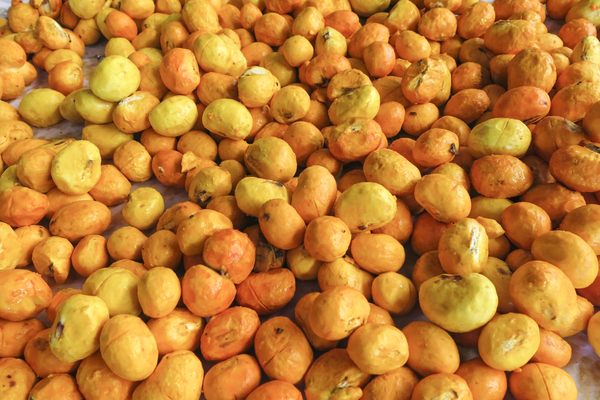Ingredients & Condiments
Baniwa Jiquitaia
Pivotal to the culture and cuisine of Brazil's Baniwa people, this piquant pepper-and-salt seasoning now provides the community with sustainable income.
Most grocery stores may have three or four kinds of peppers. The Baniwa indigenous community in Brazil’s Içana River Basin have at least 78, called aatti in their language. Ranging from koitsi hitako, the curassow beak pepper, to dzoodzo hitako, the pencil fish mouth pepper, many of these unique varieties are combined into an even more special spice: jiquitaia.
Made of dried, powdered hot peppers mixed with salt, called yuk, this mouth-burning mix is a traditional staple of the Baniwa diet, and, increasingly, a source of income for the community. Baniwa women are traditionally responsible for growing peppers. They do so as part of the coivara system of slash-and burn agriculture. After clearing the fields, women plant cassava, another dietary staple, and rainbows of hot peppers in the ash. This intricate dance of plant, human, and environment is part of the larger traditional agricultural system of the Rio Negro, of which the Içana River is a tributary. The Brazilian government granted the agricultural system official Cultural Heritage status in 2010.
Traditionally, women gather peppers every day to prepare for their families, wrapping the delicate fruits in velvety embaúba leaves. They then lay the peppers in the sun to dry, the small ones whole and the large ones chopped, for up to two weeks. The spice mixers grind the dried peppers with a wooden mortar and pestle, making sure to face away from the wind to prevent any pepper-in-the-eye accidents, then blend the powder with salt. The resulting intensely hot condiment pairs perfectly with fish, the Baniwa’s most important source of protein and their main use for the spice, though its increasing popularity has inspired chefs to use it on salads, pastas, grilled meats, and more.
Peppers have long held pride of place in Baniwa culture, agriculture, and cuisine. According to Baniwa legend, the great mythical hero Ñapirikoli brought pepper into battle with him as his shield, sword, and power. He introduced pepper to humankind when, fearing he would be poisoned at a dinner with his rivals, he sprinkled hot pepper over the fish being served to protect himself before eating. The Baniwa, too, have used hot pepper to strengthen and heal the body. Pepper also plays a role in Baniwa coming-of-age ceremonies, during which young people will—after a period of fasting and spiritual preparation—eat peppers blessed by their elders to signify they have entered the adult world.
Today, collectives of Baniwa women are turning their traditional cuisine into a sustainable modern enterprise. These efforts include Casa da Pimenta Takairo, which processes and distributes peppers grown by up to 25 families in the area. Brazilian Chef Alex Atala has helped promote these efforts, featuring the spice in his cuisine, and recently popularized it in an international TV special. Partly due to his celebrity influence, a once-local spice has now entered the world culinary stage. Luckily, while the spice is now being exported, its production remains firmly in the capable hands of the Baniwa women, who have been making jiquitaia for centuries, their lives intertwined with the tangled green tendrils of their pepper plants.
Where to Try It
-
ISA São Gabriel da Cachoeira Website
Rua Projetada, 70, Centro, São Gabriel da Cachoeira, 69750-000, BrazilThis is the Amazonas branch of the Instituto Socioambiental, the nonprofit working with Baniwa women to distribute jiquitaia. Visitors can try jiquitaia and learn more about their efforts.
-
Carambola Cozinha e Café
Rua Visconde Pirajá, 303, loja 109, Bairro Ipanema, Rio de Janeiro, 22410-001, BrazilThis café carries Pimenta Baniwa jiquitaia for purchase.
Written By
 Reina Gattuso
Reina Gattuso

















